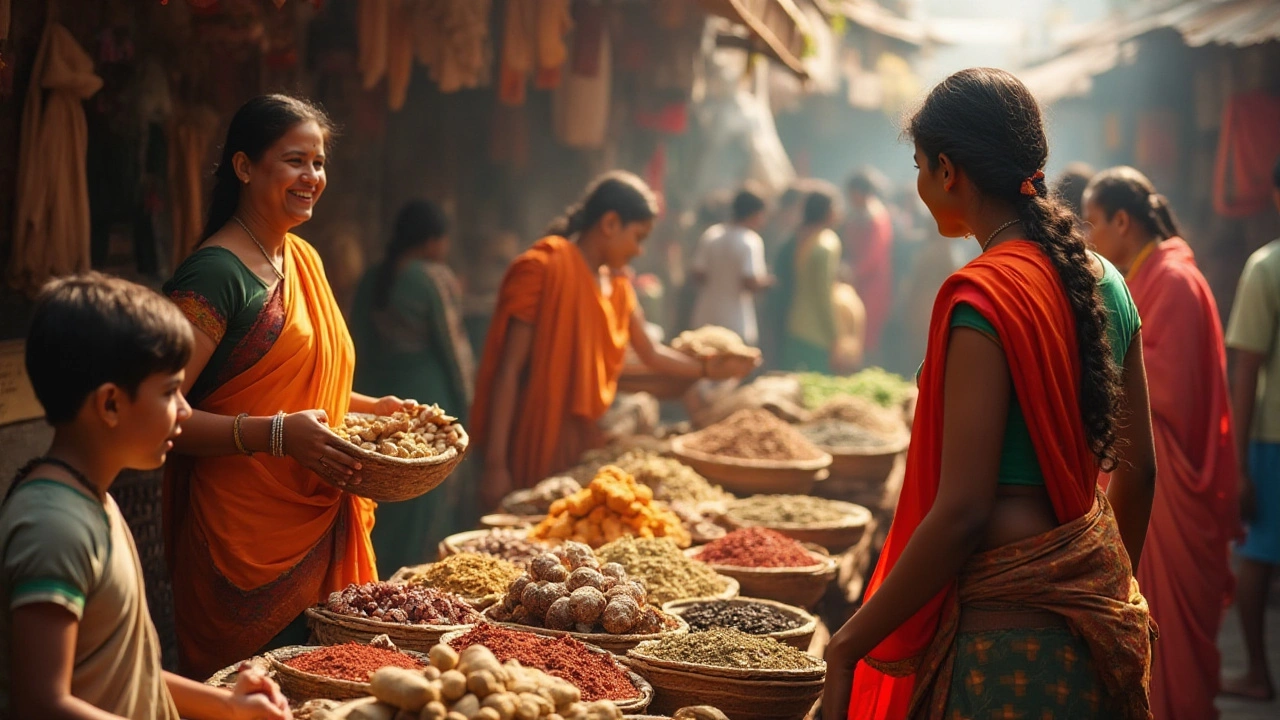
Ayurveda, the ancient healing system from India, recognizes three primary doshas or energies that influence our well-being. Among them, Vata is often described as the dosha of movement, characterized by the elements of air and space. When balanced, Vata brings creativity and vitality, but when out of sync, it can lead to unrest in the mind and body.
People with predominant Vata qualities must be mindful of their diet and lifestyle to stay centered. This involves recognizing which foods and habits can trigger imbalance. With the right knowledge, calming the frequently fluctuating nature of Vata becomes achievable, bringing peace and stability into everyday life.
- Understanding Vata Dosha
- Signs of Vata Imbalance
- Foods to Avoid for Vata Dosha
- Lifestyle Habits to Steer Clear Of
- Calming Activities for Vata
- Herbs and Remedies for Balancing Vata
Understanding Vata Dosha
The world of Ayurveda spins around the principle that everything is interconnected, and at its core lie the three doshas: Vata, Pitta, and Kapha. Vata dosha is often referred to as the 'king of doshas', since it governs all biological activity. Composed of air and space, Vata is the force behind all movement in the body, from the blinking of an eye to the beating of a heart. Those who possess a Vata constitution often display characteristics aligned with its airy nature—light, dry, cold, and changeable. Such individuals may find themselves creative, quick-thinking, and full of life, yet they are also prone to restlessness and anxiety.
When Vata is balanced, it bestows enthusiasm and adaptability. However, when thrown off course, this dosha can manifest disharmony characterized by racing thoughts, dry skin, irregular digestion, and even insomnia. The change in seasons, chaotic lifestyles, and improper diet are frequent culprits behind such imbalances. It's essential to nurture a lifestyle that pacifies Vata, focusing on stability, nourishment, and warmth. An example from traditional wisdom states, "As long as Vata is in balance, all doshas will naturally return to balance," capturing its pivotal role in maintaining equilibrium.
To delve deeper, the qualities of Vata—light, dry, and cool—also make those influenced by this dosha more susceptible to the same elements. For example, a diet rich in cold, raw foods might cause disruptions. Instead, warm, cooked meals with oily textures help in grounding Vata. Moreover, regular routines, nurturing self-care practices, and sufficient rest are crucial to keeping Vata in check. This approach is vital, not just for individuals with a predominant Vata dosha but for anyone aiming to lead a balanced and fulfilling life.
Signs of Vata Imbalance
Recognizing the signs of Vata imbalance is key to maintaining health in the realm of ayurvedic medicine. When the airy qualities of Vata become dominant, it disturbs the natural equilibrium, leading to several recognizable symptoms. A common indication is a sensation of restlessness or anxiousness, which often manifests as racing thoughts or difficulty concentrating. Individuals may find themselves overwhelmed by a plethora of ideas but unable to commit to any, which can be quite mentally exhausting.
Another glaring signal of Vata disturbance is irregular digestion. Those affected might experience a see-saw effect in their digestive patterns— from constipation to bouts of gas or bloating. This erratic process is a result of the unsettled nature of Vata which directly impacts digestive fire, known as 'Agni' in Ayurveda. Skin dryness and cracking are physical symptoms illustrating that Vata’s drying attributes are in overdrive. The skin might lose its luster, becoming rough and flaky, leading to discomfort.
Additionally, sleep patterns can become erratic for someone facing a Vata imbalance. One might have trouble falling asleep or wake up frequently during the night, leading to fatigue during the day. These restless nights can exacerbate anxiety, creating a vicious cycle of poor rest and mental turmoil. Bodily aches and pains, particularly in the joints, may also appear, reflecting the influence of the cold and mobile nature of Vata dosha.
The effect on emotions is equally profound. Feelings of insecurity, fear, and heightened sensitivity may arise. A person may become easily overwhelmed by noise or have an increased need for solitude. This emotional whirlwind is the body's cry for grounding and stability. According to renowned Ayurvedic practitioner, Dr. Vasant Lad, keeping Vata balanced involves awareness and proper lifestyle choices.
"When Vata is imbalanced, it brings chaos to the system—restoring balance involves nurturing stability and routine."
Understanding these signs allows for timely intervention through diet and lifestyle adjustments. Many often find that bringing in warmth, moisture, and stability can counter the unpredictable influence of Vata. Identifying the imbalance is the first step to reclaiming harmony, guiding one towards a more balanced state of being.

Foods to Avoid for Vata Dosha
For those familiar with Ayurveda, understanding the impact of dietary choices on Vata dosha is crucial to maintaining balance. Individuals with a Vata constitution or those experiencing a Vata imbalance need to pay close attention to their food intake. The nature of Vata is light, cold, dry, and irregular, thus, it is imperative to avoid foods that amplify these qualities. It is essential to steer clear of certain items that may exacerbate the symptoms associated with Vata imbalance, such as anxiety, dryness, and digestive issues. Choosing the right foods involves a careful balance of maintaining warmth, moisture, and regularity. Let’s explore the types of food that are best avoided and why.
Foods that are excessively dry, such as crackers or popcorn, might seem harmless, but they can significantly aggravate Vata's dry nature. As Vata is inherently cold, it's essential to skip foods like raw salads and cold cereals, which can increase the internal chill, leading to disturbed digestion. Additionally, light foods like rice cakes, while seemingly perfect for a snack, may contribute to the light and airy imbalance that Vata tends toward. It’s not just about the types of foods but also how they are cooked. Consuming a diet rich in raw foods or those without sufficient oil and spices can trigger Vata-related symptoms, leading to discomfort and unease.
Moreover, stimulants such as caffeine found in coffee and certain teas can wreak havoc on Vata individuals by enhancing their natural state of movement and irregularity. Instead, those with Vata constitution should opt for calming herbal teas or warm milk with a pinch of nutmeg. Another category of foods to be wary of is legumes, especially if not well-cooked or spiced, as they can cause bloating and gas—common Vata digestive struggles. Instead of relying heavily on beans as a protein source, it might be wiser to incorporate easily digestible proteins like eggs or warm, cooked lentils. Avoiding excessive consumption of bitter and astringent tasting vegetables, like spinach or kale when raw, is also beneficial, as these tastes increase dryness and windiness in the body's system.
"The goal in managing Vata dosha is to bring warmth, stability, and nourishment. This comes from consciously choosing foods that promote groundedness and digestion," notes Dr. Vasant Lad, a well-respected Ayurvedic physician and educator.
In terms of flavors, astringent and bitter tastes can amplify Vata's dry and light qualities, making fruits like cranberries and vegetables like raw broccoli less favorable. Instead, sweet, sour, and salty flavors should become the mainstays of a Vata-pacifying diet. Grains play a significant role; however, those that are too light, such as millet, might not provide enough nourishment or grounding effect. Aim for heavier grains like oats or rice, which can be cooked to a soft consistency, offering a sense of comfort and fullness. For those who enjoy sweet flavors, it's essential to avoid refined sugars that destabilize Vata, opting instead for natural sweeteners such as honey or maple syrup in moderation.
Understanding what to eliminate from the diet is pivotal for managing Vata imbalance, but it is equally critical to recognize the power of proper food combinations and preparation methods. By emphasizing warmth and moisture, like steamed vegetables over fresh salads, and incorporating oils and spices in meal preparation, it is possible to nourish the body while also enriching the mind. Vata individuals should consider an eating schedule that provides regularity, another cornerstone of supporting this dynamic dosha. A balanced approach can lead not just to better health, but also enhanced mental clarity and emotional well-being.
Lifestyle Habits to Steer Clear Of
Living with a predominant Vata dosha requires keen awareness of one's daily habits. Since Vata is associated with movement and change, it's important for those who embody this dosha to avoid habits that amplify its erratic nature. High-paced and unpredictable lifestyles can easily upset Vata balance, making routine a crucial component of daily life. Vata individuals should steer clear of a haphazard schedule. Instead, finding comfort in regularity, like waking up and going to bed at the same time each day, can offer a sense of stability.
Avoid skipping meals or eating at inconsistent intervals. Vata individuals benefit significantly from predictable meal times. Late dinners or irregular eating patterns may exacerbate digestive issues and increase feelings of anxiety or instability. The nervous system in Vata types can become quite reactive, so it's essential to prioritize regular, nourishing meals throughout the day. In colder months or climates, prioritizing warmth in foods, clothing, and environment can ward off feelings of chilliness or stiffness that Vata might experience. Cool, damp environments can lead to an aggravated Vata, so incorporating warm, comforting routines such as indulging in soothing baths or wearing cozy clothing can be beneficial. Excessive travel, particularly by air, can also disrupt Vata energy due to the disturbance caused by rapid movement and altitude changes. When travel is unavoidable, grounding activities such as meditation or stretching can help to keep the Vata individual anchored.
"Balance, in life and mind, is the cornerstone of well-being," says Dr. Deepak Chopra, a modern proponent of Ayurveda, emphasizing the importance of regularity and mindfulness for those with active Vata energies.
It's also advisable for Vata individuals to limit exposure to over-stimulating environments like crowded, noisy settings, which can heighten restlessness and anxiety. Instead, they should spend time in peaceful surroundings that promote tranquility and contemplation. Cultivating a routine that includes ample time for rest and reflection can prevent burnout and sensory overload. Regular mind-body practices such as yoga or tai chi offer not only physical benefits but also mental focus and calmness, aiding in balancing Vata's tendency towards scattered thoughts. For those seeking nature, urban parks or quiet gardens provide a serene backdrop to unwind and regain equanimity. Electronic screens, while unavoidable in modern life, can disturb Vata’s balance when overused. Limiting exposure and participating in digital detoxes can guard against restless nights and nervous tension often caused by this overstimulation. Engaging with digital content at least an hour before bedtime can be particularly disruptive to sleep cycles for Vata types.

Calming Activities for Vata
In Ayurveda, nurturing the delicate balance of Vata dosha is essential, given its airy and active nature. Those with this constitution often benefit from incorporating calming practices into their daily routine. These activities are designed to ground the mind and soothe the restless spirit that is characteristic of a Vata imbalance. Meditation stands at the forefront, offering a serene way to declutter the mind. Even brief sessions of mindful breathing can effortlessly anchor scattered thoughts, bringing a sense of tranquility. Regularity is key; setting aside fifteen minutes every morning and evening creates a safe haven for stillness amidst daily chaos.
Another calming endeavor is yoga, which complements the meditative practices beautifully. For Vata individuals, gentler styles such as Hatha and Yin Yoga provide harmony and alleviate pent-up tension. These styles focus on deep breathing and gradual stretching, encouraging one to connect with their body without hurried movements or unnecessary haste. Applying slow, deliberate motions, these practices restore equilibrium in the Dosha, replenishing the body's depleted energies. Integrating soothing fragrances like lavender or sandalwood during yoga amplifies the experience, adding another layer of calmness.
Embracing nature is also a powerful way to reduce Vata disturbance. Spending time outdoors, whether through forest bathing or leisurely walks, reconnects the spirit with the earth's grounding elements. Observing the serene landscapes acts as a counterbalance to Vata's inherent dynamism, recharging the spirit. Nature's silence encourages introspection, a rarity in today's fast-paced environment. The cyclic rhythm of the natural world reminds us of the importance of slowing down and savoring life's simple pleasures.
Creative activities offer a unique therapeutic benefit, letting Vata individuals harness their imaginative potential while remaining calm. These pursuits include painting, writing, or playing musical instruments. They serve as a means of self-expression, allowing the mind to flow freely while maintaining focus. Engaging in art nurtures imagination and brings forth a meditative state where positive creative energies flourish, resulting in a well-nourished spirit.
"Silence isn't empty, it's full of answers." - Socrates
Warm baths infused with calming oils such as chamomile and rose are delightful rituals for calming Vata. The slow immersion into the warm water helps alleviate physical tension, while the soft, fragrant aromas soothe the restless spirit. This simple yet effective habit is indulgent yet practical, providing a tranquil escape from the chaos of daily life. Enveloping oneself in comforting warmth promotes an inner sense of security and serenity.
It is also advised to maintain a routine, as predictability brings comfort to the otherwise unpredictable nature of Vata. Establishing regular sleep, meal times, and self-care rituals fosters a sense of stability. By doing so, the frequent swings between high energy and listlessness can be tempered, granting the mind and body a much-needed breath of fresh air, ultimately nurturing mental and physical health.
Herbs and Remedies for Balancing Vata
In the journey to stabilize the restless and airy nature of Vata dosha, the use of herbal remedies stands out as one of the most effective approaches in Ayurvedic medicine. Herbs play a vital role in countering Vata's dry and irregular tendencies, offering grounding, nourishment, and warmth. These natural allies help soothe an overactive mind and regulate bodily functions, bringing tranquility and balance.
Ayurveda recommends several key herbs for Vata balance. One of the most revered herbs is Ashwagandha, known for its adaptogenic properties that calm the nervous system and alleviate stress. This root helps in building energy reserves and enhancing overall resilience, making it an ideal choice for those facing Vata aggravation. Another powerful herb, Shatavari, renowned for its rejuvenating qualities, offers hydration and support for the reproductive system, which is often impacted by Vata disturbances.
Specific Herbal Remedies
Beyond Ashwagandha and Shatavari, there are other notable herbs that are beneficial for calming the Vata imbalance. Trikatu, a combination of black pepper, long pepper, and ginger, works to stimulate digestion and enhance circulation, crucial for Vata's often sluggish digestive fire. Licorice root, with its sweet and grounding nature, provides moisture to Vata's dryness and supports mental clarity.
An effective strategy for incorporating these herbs is through teas, decoctions, and powders. For instance, a warm cup of ginger tea can be a soothing daily ritual that not only aids digestion but also warms the body from within, countering Vata's cold nature. Additionally, a pinch of Triphala, traditionally used for its balancing effects on digestion and elimination, can be ingested at night to support regular bowel movements.
"Herbs are nature's remedy, accessible to all and able to bring a gentle balance to the bodily elements, as explained by rich traditions of Ayurveda," elaborates renowned Ayurveda practitioner Dr. Vasant Lad.
Herbal Oil Treatments
In Ayurvedic practice, herb-infused oils play a significant role, particularly in massages, to pacify Vata's ethereal qualities. These oils usually include sesame or almond oil as a base, with added herbs like brahmi or jatamansi, known for their calming effects. A self-massage routine, known as Abhyanga, which can be done before bathing, emphasizes using warm oils in circular motions, bringing grounding warmth deep into tissues.
- Vata-pacifying teas are prepared by steeping herbs like chamomile and lavender to calm anxiety and promote restful sleep.
- Herbal baths, with added rose petals and lavender, can reduce stress and create a serene environment conducive to unwinding.
- Essential oils, like sandalwood or vetiver, when diffused in the space or added to massage oils, can help focus scattered Vata energies.
By combining these herbal practices with lifestyle adaptations, one can effectively manage and balance the traits of Vata dosha. Understanding the qualities of these revered herbs and using them mindfully provides a means to harmonize the dynamic and often unpredictable nature of Vata, enabling one to enjoy a more resilient and centered state of being.
Write a comment